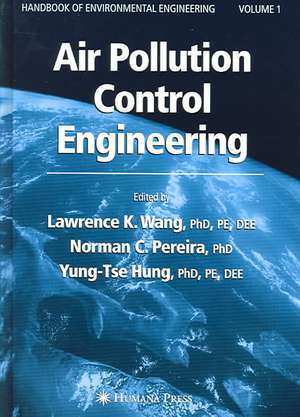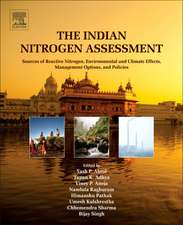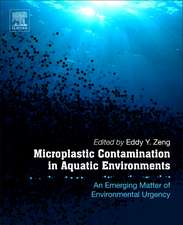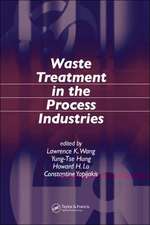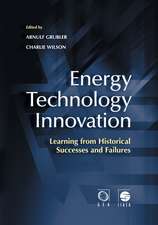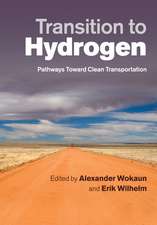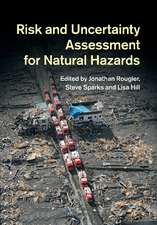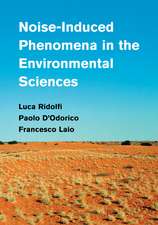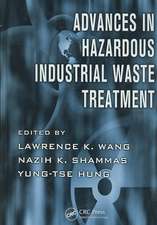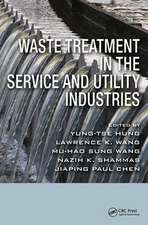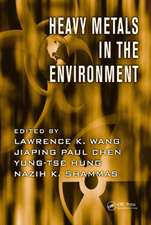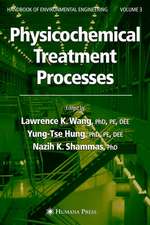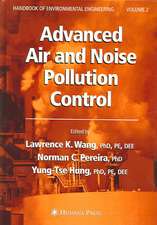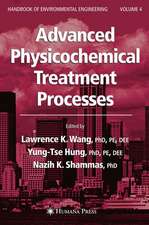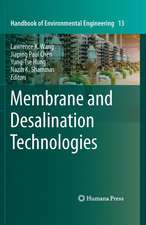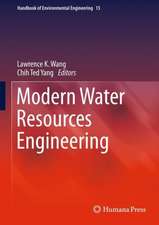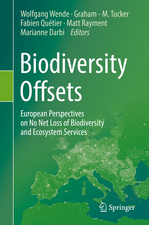Air Pollution Control Engineering: Handbook of Environmental Engineering, cartea 1
Editat de Lawrence K. Wang, Norman C. Pereira, Yung-Tse Hungen Limba Engleză Hardback – 2 iul 2004
| Toate formatele și edițiile | Preț | Express |
|---|---|---|
| Paperback (1) | 1832.53 lei 6-8 săpt. | |
| Humana Press Inc. – 19 noi 2010 | 1832.53 lei 6-8 săpt. | |
| Hardback (1) | 1838.38 lei 6-8 săpt. | |
| Humana Press Inc. – 2 iul 2004 | 1838.38 lei 6-8 săpt. |
Din seria Handbook of Environmental Engineering
- 24%
 Preț: 802.28 lei
Preț: 802.28 lei - 24%
 Preț: 797.03 lei
Preț: 797.03 lei - 24%
 Preț: 763.00 lei
Preț: 763.00 lei - 24%
 Preț: 831.34 lei
Preț: 831.34 lei - 18%
 Preț: 798.18 lei
Preț: 798.18 lei - 18%
 Preț: 969.28 lei
Preț: 969.28 lei - 18%
 Preț: 1859.67 lei
Preț: 1859.67 lei - 18%
 Preț: 1263.19 lei
Preț: 1263.19 lei - 18%
 Preț: 979.53 lei
Preț: 979.53 lei - 18%
 Preț: 1253.87 lei
Preț: 1253.87 lei - 15%
 Preț: 661.02 lei
Preț: 661.02 lei - 18%
 Preț: 1262.70 lei
Preț: 1262.70 lei - 18%
 Preț: 964.40 lei
Preț: 964.40 lei - 18%
 Preț: 967.40 lei
Preț: 967.40 lei - 15%
 Preț: 654.77 lei
Preț: 654.77 lei - 18%
 Preț: 1407.46 lei
Preț: 1407.46 lei - 18%
 Preț: 954.14 lei
Preț: 954.14 lei - 24%
 Preț: 846.32 lei
Preț: 846.32 lei - 24%
 Preț: 926.23 lei
Preț: 926.23 lei - 18%
 Preț: 1254.36 lei
Preț: 1254.36 lei -
 Preț: 399.88 lei
Preț: 399.88 lei - 15%
 Preț: 651.34 lei
Preț: 651.34 lei - 18%
 Preț: 1251.82 lei
Preț: 1251.82 lei - 18%
 Preț: 985.24 lei
Preț: 985.24 lei
Preț: 1838.38 lei
Preț vechi: 2241.93 lei
-18% Nou
Puncte Express: 2758
Preț estimativ în valută:
351.88€ • 382.35$ • 295.77£
351.88€ • 382.35$ • 295.77£
Carte tipărită la comandă
Livrare economică 22 aprilie-06 mai
Preluare comenzi: 021 569.72.76
Specificații
ISBN-13: 9781588291615
ISBN-10: 1588291618
Pagini: 504
Ilustrații: XVII, 504 p. 12 illus.
Dimensiuni: 178 x 254 x 33 mm
Greutate: 1.07 kg
Ediția:2004
Editura: Humana Press Inc.
Colecția Humana
Seria Handbook of Environmental Engineering
Locul publicării:Totowa, NJ, United States
ISBN-10: 1588291618
Pagini: 504
Ilustrații: XVII, 504 p. 12 illus.
Dimensiuni: 178 x 254 x 33 mm
Greutate: 1.07 kg
Ediția:2004
Editura: Humana Press Inc.
Colecția Humana
Seria Handbook of Environmental Engineering
Locul publicării:Totowa, NJ, United States
Public țintă
ResearchCuprins
1 Air Quality and Pollution Control.- 1. Introduction.- 2. Characteristics of Air Pollutants.- 3. Standards.- 4. Sources.- 5. Effects.- 6. Measurements.- 7. Gas Stream Calculations.- 8. Gas Stream Conditioning.- 9. Air Quality Management.- 10. Control.- 11. Conclusions.- 12. Examples.- Nomenclature.- References.- 2 Fabric Filtration.- 1. Introduction.- 2. Principle and Theory.- 3. Application.- 4. Engineering Design.- 5. Operation.- 6. Management.- 7. Design Examples and Questions.- Nomenclature.- References.- Appendix 1: HAP Emission Stream Data Form.- Appendix 2: Metric Conversions.- 3 Cyclones.- 1. Introduction.- 2. Cyclones for Industrial Applications.- 3. Costs of Cyclone and Auxiliary Equipment.- 4. Cyclones for Airborne Particulate Sampling.- Nomenclature.- References.- 4 Electrostatic Precipitation.- 1. Introduction.- 2. Principles of Operation.- 3. Design Methodology and Considerations.- 4. Applications.- 5. Problems and Corrections.- 6. Expected Future Developments.- Nomenclature.- References.- 5 Wet and Dry Scrubbing.- 1. Introduction.- 2. Wet Scrubbers.- 3. Dry Scrubbers.- 4. Practical Examples.- Nomenclature.- References.- Appendix: Listing of Compounds Currently Considered Hazardous.- 6 Condensation.- 1. Introduction.- 2. Pretreatment, Posttreatment, and Engineering Considerations.- 3. Engineering Design.- 4. Management.- 5. Environmental Applications.- 6. Design Examples.- Nomenclature.- References.- Appendix: Average Specific Heats of Vapors.- 7 Flare Process.- 1. Introduction.- 2. Pretreatment and Engineering Considerations.- 3. Engineering Design.- 4. Management.- 5. Design Examples.- Nomenclature.- References.- 8 Thermal Oxidation.- 1. Introduction.- 2. Pretreatment and Engineering Considerations.- 3. Supplementary Fuel Requirements.- 4. Engineering Design and Operation.- 5. Management.- 6. Design Examples.- Nomenclature.- References.- 9 Catalytic Oxidation.- 1. Introduction.- 2. Pretreatment and Engineering Considerations.- 3. Supplementary Fuel Requirements.- 4. Engineering Design and Operation.- 5. Management.- 6. Design Examples.- Nomenclature.- References.- 10 Gas-Phase Activated Carbon Adsorption.- 1. Introduction and Definitions.- 2. Adsorption Theory.- 3. Carbon Adsorption Pretreament.- 4. Design and Operation.- 5. Design Examples.- Nomenclature.- References.- 11 Gas-Phase Biofiltration.- 1. Introduction.- 2. Types of Biological Air Treatment System.- 3. Operational Considerations.- 4. Design Considerations/Parameters.- 5. Case Studies.- 6. Process Control and Monitoring.- 7. Limitations of the Technology.- 8. Conclusions.- Nomenclature.- References.- 12 Emerging Air Pollution Control Technologies.- 1. Introduction.- 2. Process Modification.- 3. Vehicle Air Pollution and Its Control.- 4. Mechanical Particulate Collectors.- 5. Entrainment Separation.- 6. Internal Combustion Engines.- 7. Membrane Process.- 8. Ultraviolet Photolysis.- 9. High-Efficiency Particulate Air Filters.- 10. Technical and Economical Feasibility of Selected Emerging Technologies for Air Pollution Control.- Nomenclature.- References.
Recenzii
"...the text will be equally useful for environmental engineering University students or those working in the industry." - Journal of Chemical Technology and Biotechnology
"...one of the best texts I have reviewed...excellent and strongly recommend(ed)." Journal of Hazardous Materials
"...one of the best texts I have reviewed...excellent and strongly recommend(ed)." Journal of Hazardous Materials
Textul de pe ultima copertă
Many human activities-and industrial production in particular-produce enormous quantities of wastes and pollution that require the development of major abatement technologies, processes whose implementation and costs must be justified by the degree of abatement achieved. In Air Pollution Control Engineering: Handbook of Environmental Engineering, Volume 1, a panel of eminent air pollution control educators and practicing professionals critically survey both the principles and practices involved in air pollution control processes. The authors discuss the performance, potential, and limitations of the major control processes-including fabric filtration, cyclones, electrostatic precipitation, wet and dry scrubbing, and condensation-as a basis for intelligent planning and realization of abatement systems. Additional chapters critically examine flare processes, thermal oxidation, catalytic oxidation, gas-phase activated carbon adsorption, and gas-phase biofiltration. The contributors also detail the Best Available Technologies (BAT) for air pollution control and provide cost data, examples, theoretical explanations, and engineering methods for the design, installation, and operation of air pollution process equipment. The emphasis throughout is on developing the necessary engineering from fundamental principles of chemistry, physics, and mathematics. A companion volume, Advanced Air and Noise Pollution Control, Handbook of Environmental Engineering, Volume 2, covers the use of multiple techniques to deal with air, thermal, and noise pollution.
Cutting-edge and highly practical, Air Pollution Control Engineering: Handbook of Environmental Engineering, Volume 1 offers educators, students, and practicing engineers a strong grounding in the principles of this critical field, as well as effective methods for developing optimal abatement technologies at costs that are fully justified by the degree of abatement achieved.
Cutting-edge and highly practical, Air Pollution Control Engineering: Handbook of Environmental Engineering, Volume 1 offers educators, students, and practicing engineers a strong grounding in the principles of this critical field, as well as effective methods for developing optimal abatement technologies at costs that are fully justified by the degree of abatement achieved.
Caracteristici
Includes supplementary material: sn.pub/extras
